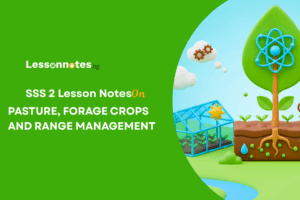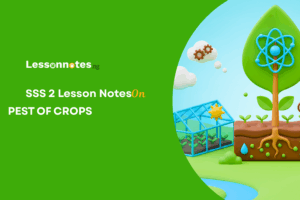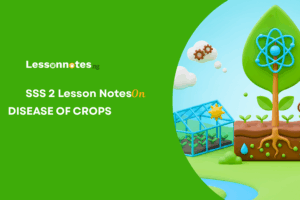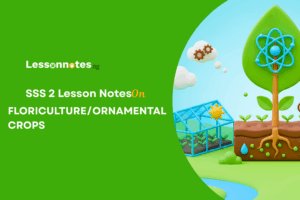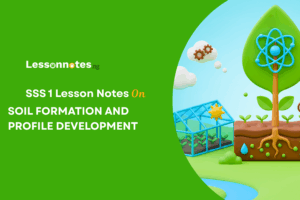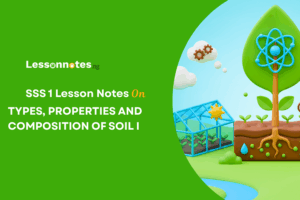Soil And Soil Formation SS1 Agricultural Science Lesson Note
Download Lesson NoteTopic: Soil And Soil Formation

Meaning of Soil
Soil can be defined as the unconsolidated weathered materials found in the uppermost layer of the earth’s surface on which plants grow. It provides support and nutrients for the plants.
Types Of Soil
The three types of soil are; Sandy Soil, Clay Soil and Loamy Soil.
- Sandy Soil: A soil is said to be sandy if the proportion of sand particles in a sample of the soil is high. The particles are mainly quartz (SiO2).
Properties Of Sandy Soil
i. Sandy soil is coarse, grained and gritty.
ii. It is loose with large pore spaces.
iii. It absorbs and loses water easily.
iv. It is not sticky when wet and cannot form a cast or ribbon.
v. It is well aerated with low water holding capacity.
vi. Percolation in sandy soil is high but capillarity is low.
vii. Sandy soil heats up easily during the day and cools down quickly in the night.
viii. It supports leaching, hence it is low in plant nutrients.
ix. It does not support waterlogging and erosion.
x. Sandy Soil has a grey or brownish color.
Methods Of Improving Sandy Soil
i. Planting of cover crops
ii. Application of compost manure
iii. Application of farmyard manure
iv. Mulching the soil
v. Avoidance of bush burning
Economic Importance Of Sandy Soil
i. It is good for the r cultivation of cassava, cotton, groundnut etc.
ii. It is good for building construction when mixed with cement.
2. Clay Soil: A soil is said to be clayed if the proportion of clay in a sample of the soil is very high.
Properties Of Clay Soil
i. The particles are fine, powdery and smooth when dry.
ii. The parties are sticky and moody when wet.
iii. The particles are tightly bound together with little pore (air) spaces.
iv. It has a high water holding capacity.
vi. It is poorly aerated.
v. Percolation in clay is low but capillarity is high.
vii. It does not support leaching, hence it contains plant nutrients.
viii. It is hard when dry and sticky when wet.
ix. It can easily form a ribbon or cast when moulded.
x. It supports waterlogging and erosion.
Methods Of Improving Clay Soil
i. Liming
ii. Addition of organic manure
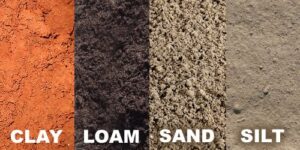
3. Loamy Soil: Loamy soil is a mixture of sand and clay particles with a high proportion of organic matter.
Properties Of Loamy Soil
i. Loamy Soil is moist and, loose with with moderate-sized pore space.
ii. The structure breaks easily when wet and friable when dry.
iii. It has s non-powdery and non-sticky texture.
iv. It can easily be worked or cultivated.
v. It contains lots of organic matter (humus).
vi. It does not support erosion and waterlogging.
vii. It was well aerated and it can hold water.
viii. It is the best soil for the cultivation of crops.
ix. It is dark brown or blue.
Component/Composition Of The Soil
The composition of the soil by percentage:
- Soil mineral matter 45%
- Soil water 25%
- Soil air 25%
- Soil living Organisms 5%
ASSIGNMENT:
- List two methods of improving clay soil.
- List the component of soil and their respective percentage composition.
- List three ways of improving sandy soil.
- List five properties of sandy soil.
- List five properties of clay soil.








